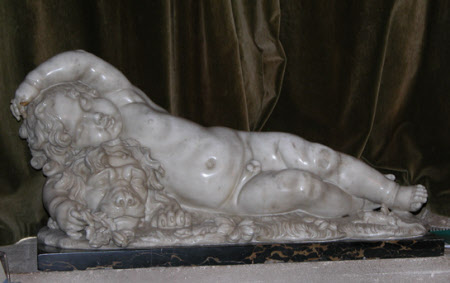Eros sleeping
Italian School
Category
Art / Sculpture
Date
c. 1720 - 1780
Materials
Marble sculpture.
Measurements
31 x 712 x 405 mm
Place of origin
Italy
Order this imageCollection
Anglesey Abbey, Cambridgeshire
NT 516572
Summary
Sculpture, marble; Sleeping Eros; Italian School; c. 1720-1780. An Italian marble figure of the sleeping Eros, lying upon a flowery sward, his body and head supported upon a sleeping lion. Mounted on Portor marble slab. This gentle sculpture is based on ancient Greek and Roman prototypes with some more modern elements, notably the lion..
Full description
A marble figure of a young winged cherub, lying asleep, his body and head resting upon a sleeping lion. The figure may also represent Cupid, god of love, but does not have his usual attributes of a bow and a quiver. The cherub’s left hand and arm lie upon his head and his right arm cradles the lion’s head. In his right hand is a sprig of poppy with full seed pods. The irregular-shaped integral marble base is in the form of a grassy sward with flowers. At right is a small lizard that seems to approach the sleeping boy and perhaps is about to nip him. Mounted on a portor marble base. One finger of the left hand is broken, another has been damaged and repaired. The concept of the Sleeping Eros, a small winged boy resting as if he has stopped for a nap in the midst of his unceasing labours to cause humans to fall in love, is found in ancient Greek and Roman art. One of the finest representations is the third-century B.C. Hellenistic bronze sculpture in the Metropolitan Museum, New York (Inv. 43.11.4; Jens M. Daehner and Kenneth Lapatin, eds., Power and Pathos. Bronze Sculpture of the Hellenistic World, exh. cat., Palazzo Strozzi, Florence and J. Paul Getty Museum, Los Angeles, Florence 2015, no. 20.). The conception of these ancient sculptures, a number of which survive, is largely repeated in the much later marble sculpture at Anglesey Abbey. The subject was popular in Greek and Roman art, with sleeping Eros sculptures being used to adorn children’s graves. They often incorporated, as in the Anglesey Abbey sculpture, a handful of poppy seeds and also a little figure of a lizard. Poppy seeds, used to make sleeping draughts, were included to give the notion that death might just be a temporary sleep. The lizard, as an animal spending winter below ground and then returning with the arrival of spring, also symbolises resurrection. In some versions of the subject, the sleeping Eros is shown with a torch lying beside him, and asleep upon a lion skin. Several Roman examples were known in the Renaissance, including one in the Uffizi in Florence, described by Giorgio Vasari as having been given by the King of Naples to Lorenzo de’Medici, as ‘a putto of black stone, sleeping, a personification of Sleep, and has wings, and a cornetto (small horn) in his hand, and in the other a poppy, and the skin of a lion underneath.’ It may have been this sculpture or another version, also still today in the Uffizi, that inspired the young Michelangelo Buonarroti to make a sculpture of this subject, which became a celebrated ‘forgery’ when it was at first taken for a genuine antiquity. Acquired by Isabella d’Este, Marchioness of Mantua, it was one of three sculptures of this subject acquired by King Charles I in the early 1630s, as part of his purchase from Mantua of the Gonzaga collections. Michelangelo’s sculpture is now lost and may have been destroyed in the Whitehall Palace fire in 1698, but copies and interpretations are known, including small bronze versions attributed to Francesco Fanelli. Numerous versions of the subject were made in Italy, in particular from the sixteenth century onwards. Many explicitly depict the sleeping figure as Cupid by including the quiver and bow, for example one in Palazzo Pitti, Florence (Inv. OdA 1911, no. 205. Maddalena De Luca Savelli, Repertorio delle sculture in Palazzo Pitti, Florence 2010, no. 28) or another attributed to the Florentine Giovacchino Fortini (1670-1736; Sandro Bellesi, Cupido. Giovacchino Fortini, Altomani and Sons, Milan 2019). There are other examples at Cliveden (NT 766160) and at Stourhead (NT 732924.1). The Anglesey Abbey sculpture is notable for its iconographical faithfulness to the antique sculptures of the Sleeping Eros, compared to the many other later versions in which he is explicitly turned into Cupid. However, the powerful presence of the sleeping lion is a very rare feature, if not completely unknown. A second-century AD figure of Eros Sleeping in the National Archaeological Museum in Athens (Inv. 5753) shows a small lion lying asleep alongside the boy, but not acting as a pillow. The powerful creature in the Anglesey Abbey sculpture is indeed more reminiscent of Antonio Canova’s lion figures, if a little more sentimental. It seems likely that the sculpture was made well into the eighteenth century, probably during the second half. Jeremy Warren November 2021
Provenance
Bequeathed to the National Trust by Huttleston Rogers Broughton, 1st Lord Fairhaven (1896-1966) with the house and the rest of the contents.
Makers and roles
Italian School, sculptor
